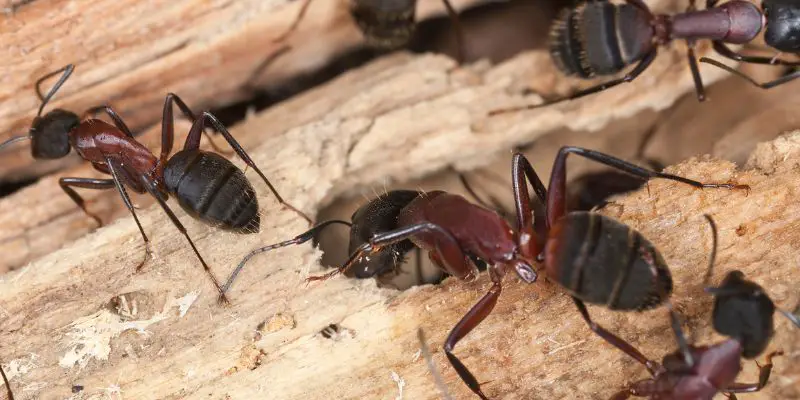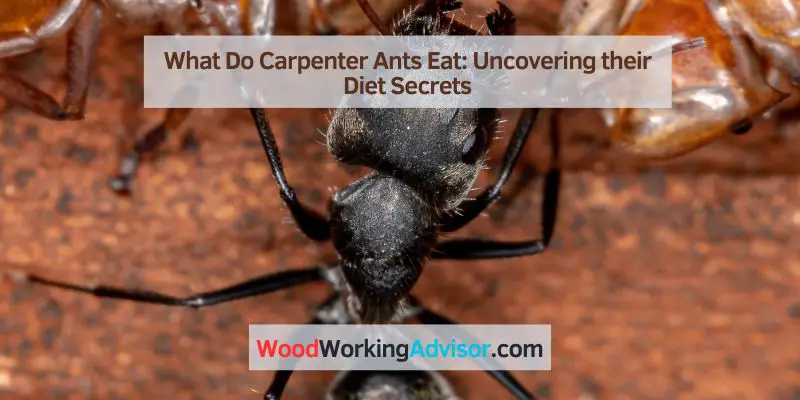Carpenter ants primarily eat sugar, proteins, and fats. They are known to feed on honeydew, insects, and plant materials, as well as human foods and leftovers.
Carpenter ants are omnivorous insects that can consume a wide variety of foods. Their diet ranges from honeydew and nectar to other insects, sweets, meats, and fats. In some cases, they can even eat human food and leftovers. Understanding the feeding habits of carpenter ants is crucial for effective pest control and prevention.
By knowing what they consume, it becomes easier to eliminate food sources and implement measures to eradicate these pests from the premises. Furthermore, being aware of their dietary preferences can guide in the development of targeted baits and traps to combat carpenter ant infestations.
Uncovering Carpenter Ants Diet Secrets
Understanding what carpenter ants eat is crucial for effective pest control. By knowing their dietary habits, you can take proactive measures to prevent infestations and protect your property. In this blog post, we’ll delve into the general dietary habits of carpenter ants and why it’s essential to grasp their diet for efficient pest management.
Introduction To Carpenter Ants And General Dietary Habits
Carpenter ants are a common nuisance in households, especially those with wooden structures. Unlike termites, carpenter ants do not consume wood, but they can cause extensive damage by excavating galleries for nesting. So, what do carpenter ants eat? These omnivorous insects have a varied diet that includes:
- Sweet Substances: Carpenter ants have a sweet tooth and are attracted to sugary foods, including nectar, fruits, and syrups.
- Protein Sources: They also feed on protein-rich foods such as meat, insects, and pet food.
- Fungi and Plant Materials: In addition, carpenter ants consume fungi and plant materials, contributing to their diverse dietary preferences.
Importance Of Understanding Carpenter Ant Diet For Effective Pest Control
Comprehending carpenter ant diet is fundamental for devising a targeted pest control strategy. By identifying their preferred food sources, you can:
- Implement Preventive Measures: Knowing that carpenter ants are drawn to sweet substances allows you to secure and properly store sugary items, minimizing their attraction to your property.
- Tailor Baits and Traps: Utilize this knowledge to customize baits and traps that specifically appeal to carpenter ants, increasing the effectiveness of pest control efforts.
- Locate Nesting Sites: Understanding their dietary habits assists in locating potential nesting sites, enabling thorough inspections and targeted treatment applications.
By acknowledging the dietary inclinations of carpenter ants, you can significantly improve the success of pest management endeavors and safeguard your home from potential infestations.
This HTML-formatted content provides valuable insight into the diet of carpenter ants while emphasizing the significance of understanding their dietary habits for effective pest control. The use of heading tags, lists, and bold text serves to make the content easily scannable and SEO-friendly, ensuring that readers can quickly grasp essential information about carpenter ant diets and pest management strategies.
What Do Carpenter Ants Eat: Natural Preferences
Carpenter ants are known for their diverse and adaptable diet. Understanding their natural preferences and dietary habits is crucial for effective pest management. Here, we delve into their primary food sources, the role of protein and sugars in their diet, and seasonal variations in food consumption.
Primary Food Sources In Their Natural Habitat
Carpenter ants primarily forage for a variety of foods in their natural habitat. Their diet consists of a mix of sugars, proteins, and fats. Their natural diet includes plant sap, sugary exudates from insects, honeydew, and other sweet substances found in plants. They also feed on live and dead insects for protein, essential for their growth and development. Additionally, they consume a variety of fruits, nectars, and even fungi.
Role Of Protein And Sugars In Their Diet
The dietary needs of carpenter ants revolve around the essential nutrients found in proteins and sugars. Proteins are essential for the development and growth of larvae, making them crucial for the ant colony’s sustenance. Sugars, on the other hand, provide a quick source of energy for the adult ants and supplement their carbohydrate requirements.
Seasonal Variations In Food Consumption
Carpenter ants demonstrate seasonal variations in their food consumption. During the warmer months, they focus more on acquiring proteins from live insects and other sources, supporting the growing population within their colonies. In contrast, during colder months, their diet shifts to high-sugar foods to sustain the existing population as they are less active.
Inside The Carpenter Ant Pantry
Carpenter ants are renowned for their adaptability and resourcefulness when it comes to finding food sources. Understanding their feeding behaviors, particularly indoors, is crucial for effective pest management. Let’s delve into the interesting world of what carpenter ants consume within human-inhabited environments.
Comparing Indoor Vs. Outdoor Feeding Behaviors
When it comes to carpenter ants, indoor and outdoor feeding behaviors exhibit noticeable distinctions. While outdoor, carpenter ants exhibit a preference for sweet substances such as honeydew from aphids, nectar from flowers, or sap from trees. Indoors, however, they are more inclined towards protein and fat-based substances.
Adaptability In Human-inhabited Environments
What sets carpenter ants apart is their innate adaptability to human-inhabited environments. They are adept at exploiting a wide array of common household items for nourishment, posing a challenge for homeowners. This adaptability enables them to thrive in various regions, making it imperative to understand their dietary preferences for effective eradication.
Common Household Items On Their Menu
Carpenter ants have an extensive menu of common household items that they are drawn to. These can include sweets such as syrup, honey, and sugar, as well as protein sources like meat, pet food, and even other insects. Additionally, they have a penchant for fats, making them attracted to products like cheese and grease. This broad dietary spectrum underscores the importance of proactive pest control measures to prevent infestations in homes.

The Impact Of Diet On Colony Health
Carpenter ants play a crucial role in their ecosystem, primarily by maintaining a delicate balance within their colonies. The impact of diet on colony health is a significant factor that influences the overall well-being and sustainability of a carpenter ant population. By understanding the relationship between food and colony growth, the influence of diet on the reproductive cycle of carpenter ants, and the effects of diet deficiencies on colony health, we can gain insight into the intricate dynamics of these fascinating creatures.
The Relationship Between Food And Colony Growth
The availability of nourishment directly affects the growth and development of carpenter ant colonies. A well-balanced diet is essential for supporting the various stages of ant life, from the nurturing of larvae to the sustenance of adult workers. The availability of rich sources of protein, sugars, and fats enables carpenter ant colonies to thrive and expand, ultimately contributing to their overall vigor and productivity.
Diet Influencing The Reproductive Cycle Of Carpenter Ants
The diet of carpenter ants plays a crucial role in regulating their reproductive cycle. When provided with an adequate supply of nutrients and resources, carpenter ants are better equipped to support the development of reproductive individuals within the colony. Conversely, a lack of essential nutrients can hinder the reproductive capabilities of the colony, potentially leading to a decline in population numbers and genetic diversity.
Diet Deficiencies And Their Effects On Colony Health
Diet deficiencies can have detrimental effects on the overall health of carpenter ant colonies. Inadequate nutrient intake can lead to weakened immune systems, reduced fertility, and impaired development of larvae, ultimately impacting the colony’s ability to sustain itself. By addressing and mitigating diet deficiencies, colony health and resilience can be significantly enhanced.
Managing Carpenter Ants Through Diet Intervention
Welcome to our blog post on managing carpenter ants through diet intervention. Carpenter ants can be a nuisance in homes and businesses, and understanding their dietary preferences can be key to effective pest control. By managing the diet of carpenter ants, we can limit their food sources, encourage natural predators, and use their diet preferences against them with targeted baits.
Strategies For Limiting Food Sources In Pest Control
Carpenter ants are attracted to a variety of foods, including sweets, proteins, and fats. To limit their food sources and discourage their presence, it is important to:
- Store all food in airtight containers to prevent access
- Regularly clean up food crumbs and spills
- Dispose of trash in sealed bins
Encouraging Natural Predators By Manipulating Diets
Encouraging natural predators of carpenter ants can help to control their population. By controlling their diet, we can attract predators such as spiders, birds, and lizards. Creating habitats for these predators and providing them with suitable food sources can help to naturally manage carpenter ant populations.
Carpenter Ant Baits: Using Their Diet Preferences Against Them
Carpenter ant baits are an effective way to use their diet preferences against them. By using materials that carpenter ants are attracted to, such as sugar and protein-based baits, we can strategically place these baits to target and eliminate colonies. This method leverages their natural feeding habits to control and remove carpenter ant infestations.
Frequently Asked Questions For What Do Carpenter Ants Eat
What Attracts Carpenter Ants In A Home?
Carpenter ants are attracted to homes by food sources like sugary and greasy items, as well as damp wood. They seek out warm, moist environments for nesting, such as in wall voids or near plumbing. Ensuring proper food storage and addressing moisture issues can help prevent infestations.
What Do Carpenter Ants Hate The Most?
Carpenter ants hate strong smells like peppermint, vinegar, and citrus. Use these scents to repel them.
What Is The Fastest Way To Get Rid Of Carpenter Ants?
The fastest way to get rid of carpenter ants is to locate and remove their nest, seal entry points, and use insecticidal bait or spray. Professional pest control can also provide effective and fast elimination. Regular inspection and maintenance help prevent future infestations.
What Makes Carpenter Ants Go Away?
To get rid of carpenter ants, use bait traps or seek professional pest control services. Remove food sources and seal entry points. Regular cleaning and maintenance can also prevent infestations.
Conclusion
In understanding what carpenter ants eat, we can see the importance of addressing and preventing their presence in our homes. By eliminating food sources and maintaining a clean environment, we can reduce the risk of infestations. Additionally, seeking professional help if necessary is crucial for the safety and wellbeing of our living spaces.



3 thoughts on “Uncovering the Diet of Carpenter Ants: What They Really Eat and Why It Matters”